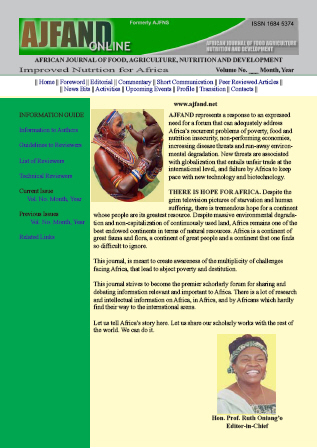
|
African Journal of Food, Agriculture, Nutrition and Development
Rural Outreach Program
ISSN: 1684-5358
EISSN: 1684-5358
Vol. 17, No. 1, 2017, pp. 11603-11615
|
 Bioline Code: nd17013
Bioline Code: nd17013
Full paper language: English
Document type: Research Article
Document available free of charge
|
|
|
African Journal of Food, Agriculture, Nutrition and Development, Vol. 17, No. 1, 2017, pp. 11603-11615
| en |
TACKLING COMMUNITY UNDERNUTRITION AT LAKE BOGORIA, KENYA: THE POTENTIAL OF SPIRULINA (ARTHROSPIRA FUSIFORMIS) AS A FOOD SUPPLEMENT
Yin, C; Daoust, K; Young, A; Tebbs, EJ & Harper, DM
Abstract
Undernutrition remains a major public health concern for many developing nations, particularly in sub-Saharan Africa. In Kenya, undernutrition affects a substantial portion of the Kenyan population, especially children and those living in rural areas. Local and sustainable means of addressing undernutrition is still lacking in many communities in urban, but more so in rural areas of Kenya. Spirulina (Arthrospira fusiformis), a cyanobacterium from alkaline inland waters, high in nutrient content, is a potential means of treating undernutrition in the developing world, where it can be easily grown. This paper presents a feasibility study on the harvest of Spirulina from Lake Bogoria in the Kenyan Rift Valley for use as a food supplement for undernutrition mitigation in the surrounding rural communities. A nutrition survey revealed the local population to be deficient in a number of micronutrients, specifically vitamins E and B12 that could be provided through dietary supplementation with Spirulina. A sample of Spirulina was collected from Lake Bogoria and analyzed for nutrient content and the presence of toxins. It was found that Lake Bogoria Spirulina had a dry protein content of 14.6% and is a rich source of dietary iron, with an iron content of 1.86%. A toxicity analysis revealed that Lake Bogoria Spirulina contained 1.15ng/g of microcystins (a group of hepatotoxic small polypeptides produced by several strains of cyanobacteria), which is within levels safe for human consumption according to World Health Organization standards. It was concluded that Lake Bogoria Spirulina is an easily accessible source of food and has the potential to be a sustainable means for the Lake Bogoria community to tackle undernutrition. Finally, using the data gathered, consultation sessions were arranged with key community groups and members to discuss the feasibility and potential for incorporation of Spirulina into the local diet – an ongoing collaborative process between researchers and the community that has already been met with some success.
Keywords
Spirulina; food; diet; undernutrition; Bogoria; toxicity; microcystins; community; Landsat
|
| |
© Copyright 2017 - African Journal of Food, Agriculture, Nutrition and Development
Alternative site location: http://www.ajfand.net/
|
|
